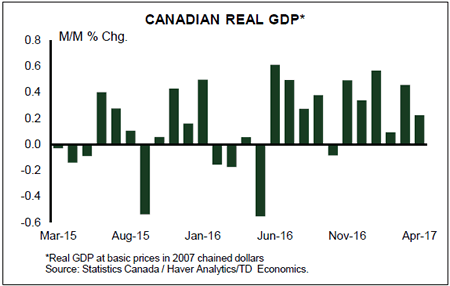U.S. Highlights
- It was a light domestic data week with investors focused on politics, central banks, and international data. U.S. equities set new records with the S&P 500 a mere 25 points from 2,500. while the dollar weakened broadly.
- China’s economy grew by 6.9% y/y in Q2 with broad-based gains. The robust headline, alongside consensus-beating details helped shore up confidence in the evolving and decelerating economy.
- Despite the unchanged policies and dovish tone from the BoJ and ECB both the yen and euro strengthened.
- U.S. data was robust but not market-moving, with investors looking forward to FOMC and Q2 GDP next week.
Canadian Highlights
- This week’s economic data continues to support the view that another Bank of Canada rate hike is coming in October.
- Retail spending data this week showed that consumers strengthened their grip on the growth baton. With retail sales up 1.1% in real terms in May, second quarter consumer spending growth looks to exceed 3% (annualized).
- Overall economic growth is also on track for a gain of 3% or higher in the second quarter, firmly in line with the Bank of Canada’s July forecast.
- Meanwhile, two of the Bank of Canada’s core inflation measures ticked up for the first time in several months.

U.S. – More Growth…. Less Inflation
It was a light week for domestic economic data with investor focus primarily on political events, G7 central banks, and international data. China kicked off the week with the release of economic growth estimates for the second quarter. The world’s second largest economy grew by 6.9% in Q2 with gains broad-based. The robust headline, alongside consensus-beating details helped shore up confidence in an evolving and slowing economy with the strength of the largest consumer of materials providing some support to commodity prices.
Oil got a further lift from a bullish U.S. inventory report, with a brief recovery developing before petering out on Friday morning. Still, commodity-exposed currencies did fairly well (see Chart 1). The Norwegian krone and Brazilian real were up about 2% vis-à-vis the greenback, while the antipodes gained half that. Equity markets also fared well. U.S. indices, helped by strong earnings and a pullback in the dollar to a one-year low, reached record peaks by mid-week. Tech and health care stocks led, with the latter boosted by diminishing prospects for ACA repeal. Equities in Hong Kong and China also did well, with U.K. indices boosted by the recent pound depreciation. On the other hand, Japanese and European equities suffered losses as their currencies strengthened by 0.9% and 1.5% relative to the U.S. dollar on the week.
Paradoxically, the yen and euro appreciated despite the dovish stance communicated on Thursday by both the Bank of Japan (BoJ) and the European Central Bank (ECB). The BoJ left the policy rate unchanged and will continue to buy assets for some time still. The BoJ upgraded the growth forecast for the Japanese economy, but also lowered the inflation forecast and pushed out its timeframe for achieving the inflation target. Gov. Kuroda now expects inflation to reach 2% a year later than previously projected, or by March 2020. This is the sixth time that the BoJ pushed out the timeline under his tenure. .
A similar theme is apparent in the Eurozone. Growth projections were lifted over the medium-term while inflation forecasts have been downgraded, with inflation unlikely to hit ECB’s 2% target this decade. Importantly, in the latest press conference ECB President Draghi communicated that inflationary momentum in the Eurozone is not self-sustaining and the ECB is in no rush to taper its bond purchases at this point so as to maintain support.
U.S. economic data were relatively constructive. The pace of homebuilding bounced back above the 1.2 million annualized pace, Empire and Philly surveys telegraphed robust growth, and jobless claims fell to 233 thousand. Still, the robust data offered little to support the greenback, with political uncertainty related to the ACA, debt ceiling, and NAFTA remaining front-and-center. The dollar also lacked Fed hawks’ support with the FOMC in a 10-day blackout period ahead of next week’s policy meeting. While we only expect only minor tweaks to the policy statement we look forward to the post-meeting speaking circuit in anticipation of updated Fed communication, which remains at odds with markets on upcoming rate hikes. We believe that the truth about rate hikes in the next eighteen months is somewhere between the market’s two and Fed’s four. Moreover, while we can’t rule out a hike later this year, the probability of such a move is diminished at this point, especially taken together with balance sheet normalization slated to begin in the fall.
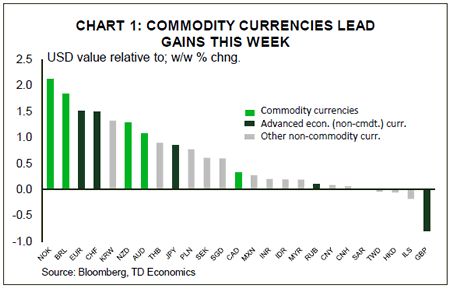
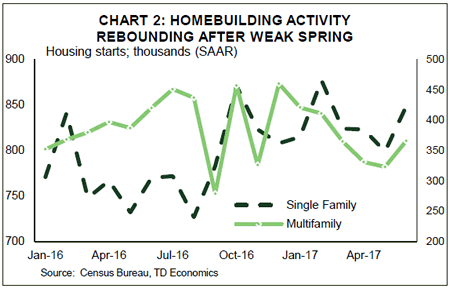
Canada – Where to From Here?
This week brought with it a slew of economic data to support the view that the Bank of Canada will continue to raise rates in October.
Perhaps most importantly, consumers are strengthening their grip on the growth baton. Retail spending was up 0.6% in May and a colossal 1.1% in real terms. Autos remained a key area of strength, suggesting that households remain confident in their future economic prospects. Overall, consumer spending is on track to grow by 3.2% (annualized) and should contribute almost 2 percentage points to economic growth last quarter. Overall, Real GDP growth is expected to come in above 3% (annualized) in the second quarter, squarely in line with the Bank of Canada’s July forecast.
The Bank of Canada opted to ignore soft consumer price growth in its decision to lift the overnight rate last week, emphasizing temporary factors weighing on inflation and noting that improving economic conditions would eventually help lift it back to its 2% target. This week’s CPI report may be the first step in that direction. Overall inflation edged lower to 1.0% (year-on-year) in June, as falling energy prices (-1.3% y/y) weighed on the headline number. Notably, however, two of three of the Bank of Canada’s core inflation measures edged up for the first time in several months. The turn in core inflation, while nascent, is in line with the central bank’s expectation for a firming in underlying price pressures.
The housing market continues to offer a note of caution for future growth. The June data out this week recorded a third month of declining activity. Existing home sales fell 6.7% in the month, led by a sharp drop in markets in Ontario. In Toronto, existing home sales are down a whopping 42% peak-to-trough. Weakness was also pretty widespread across markets outside of Ontario. The recovery in Vancouver seems to have petered out, with sales now down for two months in a row. Meanwhile, total sales excluding BC and Ontario were down 3.9%.
The slowdown in national home sales is unlikely to sway the Bank of Canada from raising rates, however. For one, home price growth remains robust, which will only continue to add fuel to the consumer spending binge. While average home price growth slowed to 0.4% in June, that largely represented a shift in sales away from more expensive markets like Toronto and Vancouver to cheaper markets like Montreal and Ottawa. Adjusted for quality, home prices were still up 15.8% year-over-year. Second, the sales adjustment has been largely policy-driven, the impact of which has historically proven to be temporary. Ultimately, it will be higher interest rates that will keep housing activity from re-accelerating.
Overall, consumer led-economic growth in Canada has accelerated to a pace that no longer warrants emergency level interest rates. As long as economic activity remains robust, it will continue to eat into economic slack. At this point, an additional hike this October seems assured. Provided that the global economy cooperates, the downturn in housing remains contained, and inflation eventually moves higher, the central bank will likely raise rates another two times in 2018.
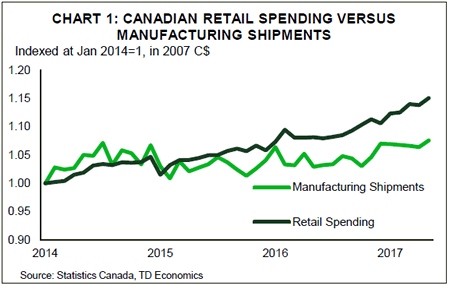
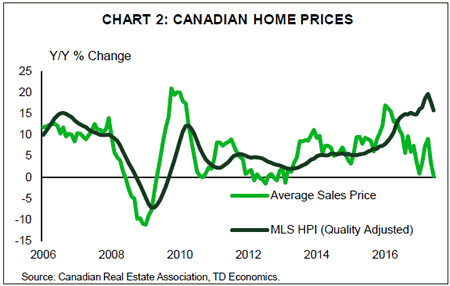
U.S.: Upcoming Key Economic Releases
U.S. Real GDP- Q2 Advance Estimate
Release Date: July 28, 2017
Previous Result: 1.4%
Previous Result: 1.4%
Consensus: 2.5%
The advance GDP release is likely to confirm a pickup to an above-trend pace following the Q1 disappointment. We are near the market consensus for a 2.5% annual rate, reflecting a robust pickup in consumer spending and a further advance in nonresidential business investment. We look for real consumer spending (PCE) to reaccelerate to near a 3% pace while business investment should reflect growth across all sub-categories. Both residential investment and net exports, however, should be a small drag, partially offset by inventory accumulation. A GDP print closer to 2% would be taken negatively by markets, as weaker than expected growth amid low inflation can be expected to lower the Fed’s conviction in its policy rate path.
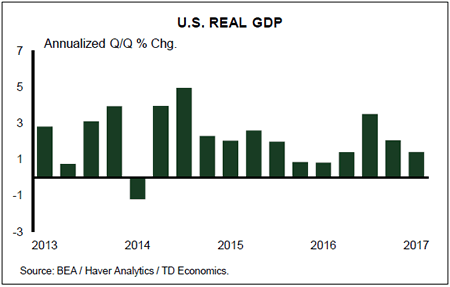
Canada: Upcoming Key Economic Releases
Canadian Real GDP – May
Release Date: July 28, 2017
Previous Result: 0.2% m/m
TD Forecast: 0.2% m/m
Consensus: N/A
Industry level GDP should rise by 0.2% in May, matching the prior month. We expect growth to reflect strength in goods and services, though both should receive significant support from the auto industry. Manufacturing output surged in May on the strength of motor vehicle shipments and automobiles accounted for all of the growth in nominal retail sales. Meanwhile, a sharp cooling in the Toronto housing market should provide an offset through the conduit of residential construction and broker commissions, though the latter is admittedly a small portion of the wider industry. With the headwinds from real estate likely to persist into Q3 and consumer spending unlikely to repeat its blockbuster performance, we may be at the peak of the current cycle. Our forecast for a 0.2% monthly print translates into 4.1% advance on a year-ago basis, though base-effects from the Fort McMurray wildfires are sizeable.
With Q2 GDP tracking at 3.2%, the real side of the economy is performing in line with the Bank of Canada’s expectations, signaling a high likelihood for a 25bp hike in October.
